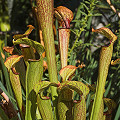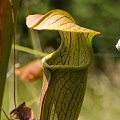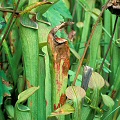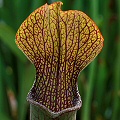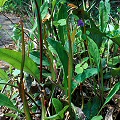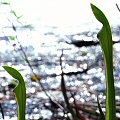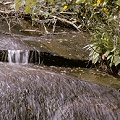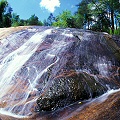Q: About Sarracenia jonesii, the mountain pitcher plant
A: Sarracenia jonesii looks very much like a large version of
Sarracenia rubra subsp. rubra; while the pitchers of
S. rubra are about 26-45 cm tall and 1.5-2.3 cm across at the mouth, the pitchers of
S. jonesii are 43-61 cm tall and 2.8-4.2 cm across at the mouth. Don Schnell always makes a point
of noting that the pitcher tube for S. jonesii expands slightly in the upper third of the pitcher,
and then constricts just at the mouth. However, this character, like the pitcher sizes I quote above, is variable and depends
upon how well the plants are growing. I freely admit that a few times I have been asked if such-and-such cultivated plant is really
S. jonesii or just S. rubra, and I could not be sure!
Despite Wherry's observations to the contrary, I can detect a raspberry scent in the little red flowers of
S. jonesii.
An anthocyanin-free form exists, which I treat with the name
Sarracenia jonesii f. viridescens.
Range
States: North Carolina, South Carolina.
Found only at
about ten sites in the mountains of North Carolina (Buncombe, Henderson, Transylvania Counties) and South Carolina
(Greenville, Pickens County). It may also be encountered at a few more artificial plantings.
Sarracenia jonesii is extremely
endangered; the few populations that remain are stressed by changes in water hydrology, in particular decreased water flow
and degrading water quality. This plant is listed as "Endangered" within the USA and is on CITES Appendix I;
read the appropriate FAQ entries on these laws to understand the ramifications of these listings if you want to buy, sell, or trade these
plants. Poaching has also been a problem. This poaching has made it very difficult for carnivorous
plant enthusiasts to visit S. jonesii in the wild, because conservation workers are
extremely reluctant to reveal location data. For example, there is an all-green (anthocyanin-free) variant of
Sarracenia jonesii that no longer occurs in the wild because poachers have stolen every plant.
The anthocyanin-free plant is commonly cultivated, but it is interesting to reflect that every specimen in cultivation is
derived from illegally collected stock. Do such plants ever become ethically clean? I wonder...
Something I really like about Sarracenia jonesii is that it sometimes occurs at sites called
"cataract bogs." These are places where the surface water sheets out over huge, sloping granite slabs. These are
exceedingly treacherous water slides---I am sure they would be huge fun to slide down the bare rock surfaces, except that you would die
in a crumpled, broken heap among the boulders at the bottom of the slide.
The plants cling to the membrane of soil, detritus, and Sphagnum that forms an apron at the edges of these
slides, or in little clumps here and there in the middle of the slide where roots can find a crack to grip.
The sites are as beautiful as they are dangerous.
So now, we come to the controversy of the name for this plant. When it was first described in 1929, Wherry called it
Sarracenia jonesii (the usage I have adopted). Bell thought that Wherry made a mistake in judgement, and in
1949 he reduced this plant's status to that of a mere form, i.e.
Sarracenia rubra f. jonesii. McDaniel, in 1971, felt that none of the
Sarracenia rubra-complex plants (including S. jonesii and
S. alabamensis) should be given any separate status of any kind, and that
S. rubra should just be considered a single polymorphic species.
In 1972, Wherry revised his published opinion, establishing the plant as a subspecies, i.e.
Sarracenia rubra subsp. jonesii. Workers remain divided on this issue even
today, and are roughly in two camps. Case & Case are the iconic leaders of those who prefer using the species designation
(S. jonesii), while Don Schnell is the grand poobah of those who
prefers the usage S. rubra subsp. jonesii. In his treatment with McPherson
in 2011, he maintained his perspective.
So, you might ask what is the "correct" usage. The simple answer is that whichever of the names you use is your own
decision. The question on whether this plant is a separate species or a S. rubra subspecies
cannot be easily determined by any test or geographical survey---it is ultimately a matter of opinion and a judgement call.
And there, my friend, is the core of the controversy. I prefer the separate species status because, when I am looking at
a native, healthy population of S. jonesii, they just look different enough from slender little
pinstriped S. rubra to convince me they are separate species.
At risk of being overly repetitive, I show you again the tables comparing the two treatments of plants in this so-called
"S. rubra complex."
- Method #1--as per McPherson & Schnell (2011)
- Sarracenia rubra Walt.
- S. rubra subsp. alabamensis (Case & R.B.Case) S.McPherson & D.E.Schnell
- S. rubra subsp. gulfensis D.E.Schnell
-
- S. rubra subsp. gulfensis f. luteoviridis S.McPherson & D.E.Schnell
-
- S. rubra subsp. jonesii (Wherry) Wherry
-
- S. rubra subsp. jonesii f. viridescens S.McPherson & D.E.Schnell
-
- S. rubra subsp. wherryi (Case & R.B.Case) D.E.Schnell
- S. rubra 'Incompletely diagnosed taxon from Georgia and South Carolina’
- Method #2--as per me
- Sarracenia alabamensis Case & R.B.Case
- S. alabamensis subsp. wherryi Case & R.B.Case
- Sarracenia jonesii Wherry
-
-
- S. jonesii f. viridescens (S.McPherson & D.E.Schnell) B.Rice
-
-
- Sarracenia rubra Walt.
- S. rubra subsp. gulfensis D.E.Schnell
-
- S. rubra subsp. gulfensis f. luteoviridis S.McPherson & D.E.Schnell
-
- S. rubra subsp. viatorum B.Rice
- S. rubra subsp. gulfensis D.E.Schnell
In the end, I do not care a rat's bum about this point---my interest is in the conservation. If you ever get to see a
cataract bog, with water sliding over the surface of the rock and Sarracenia clinging for life
on its edges, I think you would agree that whatever the hell you want to call them, we should not kill these organisms by our
own stupidity and carelessness.
Page citations: Case, F.W., and Case, R.B. 1976; CITES, 1992;
Determann, R. 2000, private communication; McDaniel, S. 1971; McPherson, S. & Schnell, D. 2011;
Murdock, N. 2000, private communication;
Rice, B.A. 2001a, 2006a, 2012a, 2018, 2019; Schnell, D.E. 2002a; US Fish & Wildlife Service, 1973; Wherry, E.T. 1929.
